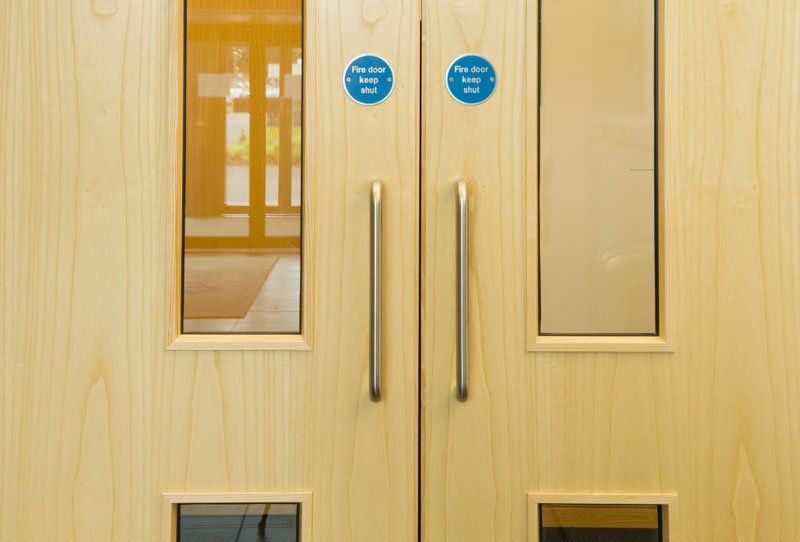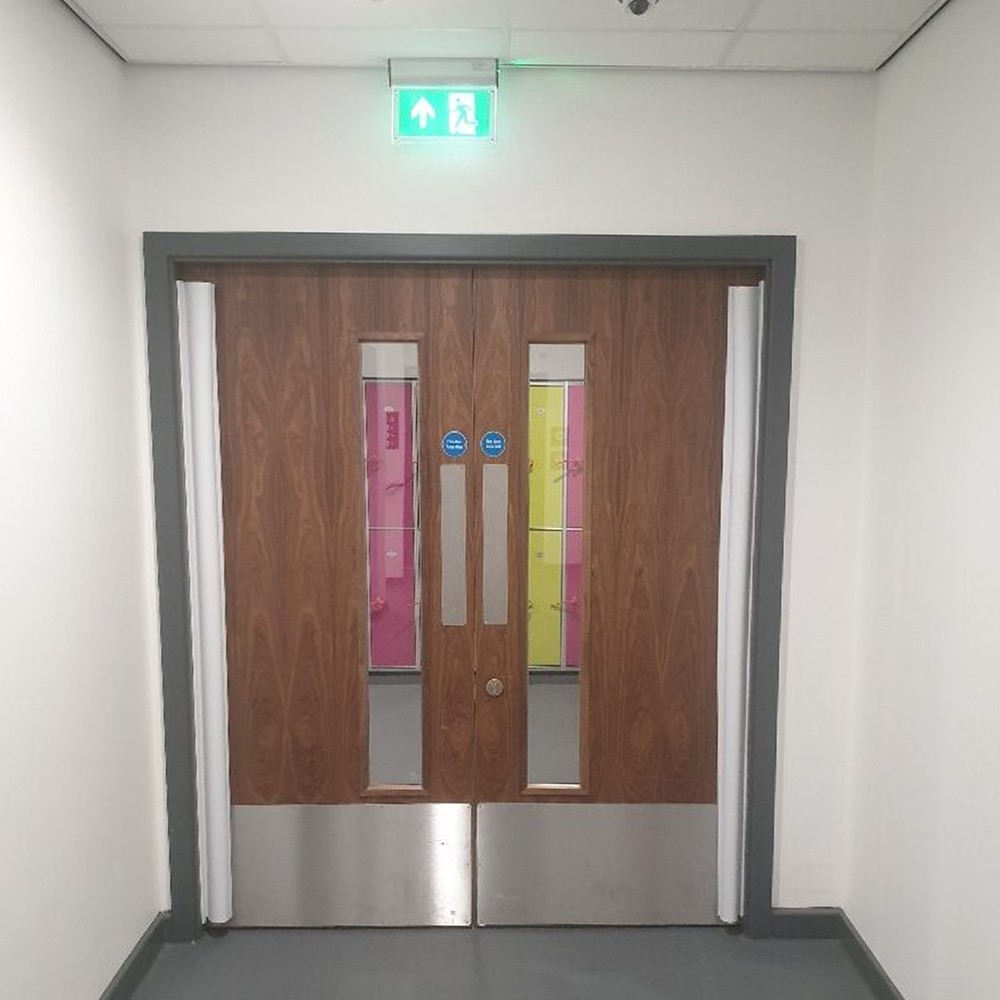Fire Doors: Recognizing Their Role in Fire Defense and Security Codes
Fire Doors: Recognizing Their Role in Fire Defense and Security Codes
Blog Article
Comprehending the Various Sorts Of Fire Doors for Enhanced Security
From basic fire-rated doors that protect against fires to acoustic fire doors that offer both fire resistance and audio insulation, each kind is made with particular features in mind. The combination of glass fire doors and the necessity of fire leave doors even more highlight the complex nature of fire door applications.
Standard Fire-Rated Doors
Common fire-rated doors are an essential component in ensuring structure safety and conformity with fire laws. These doors are specifically made to stand up to the spread of fire and smoke, providing crucial defense to owners and home. Built from materials such as steel, gypsum, and fireproof timber, they can withstand heats and preserve structural integrity for varying periods, commonly ranging from 20 mins to three hours.
The efficiency of typical fire-rated doors is evaluated by their fire-resistance ranking, which is determined via extensive testing under controlled problems. This ranking suggests the duration throughout which the door can include fires and warmth, thus enabling added time for discharge and emergency situation feedback. Furthermore, these doors frequently feature intumescent seals that broaden when exposed to warm, additional stopping the passage of smoke and harmful gases.
Installation of common fire-rated doors must abide by stringent building ordinance and requirements, such as those set by the National Fire Defense Association (NFPA) and the International Building Code (IBC) Routine inspections and maintenance are crucial to ensure that these doors operate correctly in an emergency. Correctly mounted and kept fire-rated doors are indispensable in improving total structure safety and decreasing fire-related risks.
Smoke Doors
Smoke doors play a critical role in fire safety by particularly attending to the containment of smoke, which is commonly extra harmful than fires during a fire occurrence. Smoke breathing can lead to extreme respiratory system issues, disorientation, and even fatalities, making smoke doors a critical component in emergency situation planning. These doors are designed to limit the movement of smoke in between different compartments within a building, therefore providing much safer evacuation routes and lowering possible damages to residential or commercial property.

Furthermore, smoke doors are usually furnished with automated closing mechanisms, triggered by smoke alarm or smoke alarm, to ensure they close quickly during an emergency situation. By containing smoke, these doors aid preserve reduced temperatures and clearer visibility in escape routes, making them a crucial aspect in extensive fire safety techniques. Their appropriate installment and upkeep are vital to guarantee optimal performance when most needed.
Acoustic Fire Doors
Acoustic fire doors offer a double function in both fire safety and security and sound depletion, making them a valuable addition to structures where noise control is crucial. These doors are engineered to not only meet strenuous fire resistance standards but likewise to considerably minimize sound transmission, consequently enhancing overall building performance.
The construction of acoustic fire doors typically entails a combination of thick materials and specialized seals. These elements function with each other to develop an effective obstacle against both fire and sound. High-density cores, such as mineral boards or composite materials, are typically made use of go to the website in the door leaf to optimize audio insulation. Additionally, the door structure and seals are created to keep acoustic honesty while offering durable fire resistance.
Acoustic fire doors are specifically useful in environments where personal privacy and peaceful are extremely important, such as health centers, resorts, and schools. They aid to preserve a calm environment by minimizing the transmission of audio between spaces or hallways while making sure conformity with fire safety policies. In addition to their useful advantages, these doors can be tailored to blend seamlessly with the building looks of a structure, making certain that security does not come with the expenditure of design.

Glass Fire Doors
Glass fire doors, often used in modern-day building designs, supply a blend of transparency and safety that conventional fire doors can not match. These doors incorporate the aesthetic allure of glass with crucial fireproof buildings, making them an optimal choice for contemporary structures. Engineered with specialized fireproof glazing, glass fire doors can endure heats and stop the spread of flames and smoke for why not try this out a defined duration, generally varying from 30 to 120 mins.
The building of glass fire doors involves several layers of solidified glass, often treated with intumescent products that expand when revealed to heat, further boosting their fireproof capabilities. These doors are not just functional in regards to fire security yet also permit natural light to penetrate via areas, adding to energy efficiency and a much more inviting environment.
Furthermore, glass fire doors can be integrated with different framing materials such as steel or aluminum, which give extra structural support and durability. Making use of such doors is especially useful in commercial, educational, and medical care settings where visibility and safety and security are critical. By meeting strict fire security regulations and preserving an open, click over here modern-day visual, glass fire doors represent a pivotal technology in fire-resistant building and construction.

Fire Departure Doors
Fire leave doors are an essential component of any type of building's security infrastructure, developed to provide a swift and safe means of egress during emergency situations. These doors are strategically located to guarantee occupants can rapidly and safely leave the properties in case of a fire or various other hazardous circumstances. Unlike standard doors, fire escape doors should stick to rigid regulative standards, guaranteeing they can perform dependably under duress.
A vital feature of fire leave doors is their capacity to open easily from the within, usually geared up with panic bars or push pads. This design assists in rapid evacuation and prevents bottlenecks that can occur during high-stress scenarios. In addition, fire departure doors are usually built from fire-resistant materials to prevent the spread of flames and smoke, thus supplying crucial added time for emptying and firefighting efforts.
An additional crucial aspect is the clear signs and lighting related to fire departure doors. Appropriate signage makes certain that these departures are easily identifiable also in low-visibility problems. Normal upkeep and inspections are critical to assure that these doors function appropriately when required. Eventually, the efficiency of fire departure doors is an important element in safeguarding lives and lessening building damage during emergency situations.
Verdict
In recap, comprehending the different types of fire doors, consisting of typical fire-rated doors, smoke doors, acoustic fire doors, glass fire doors, and fire leave doors, is essential for improving safety and security in buildings. Each type supplies certain benefits, from fire and smoke containment to sound insulation and visual assimilation, making certain detailed protection. Fire doors. Routine maintenance and conformity with safety requirements are important to guarantee their effectiveness in protecting passengers and assisting in secure discharge throughout emergency situations
Report this page